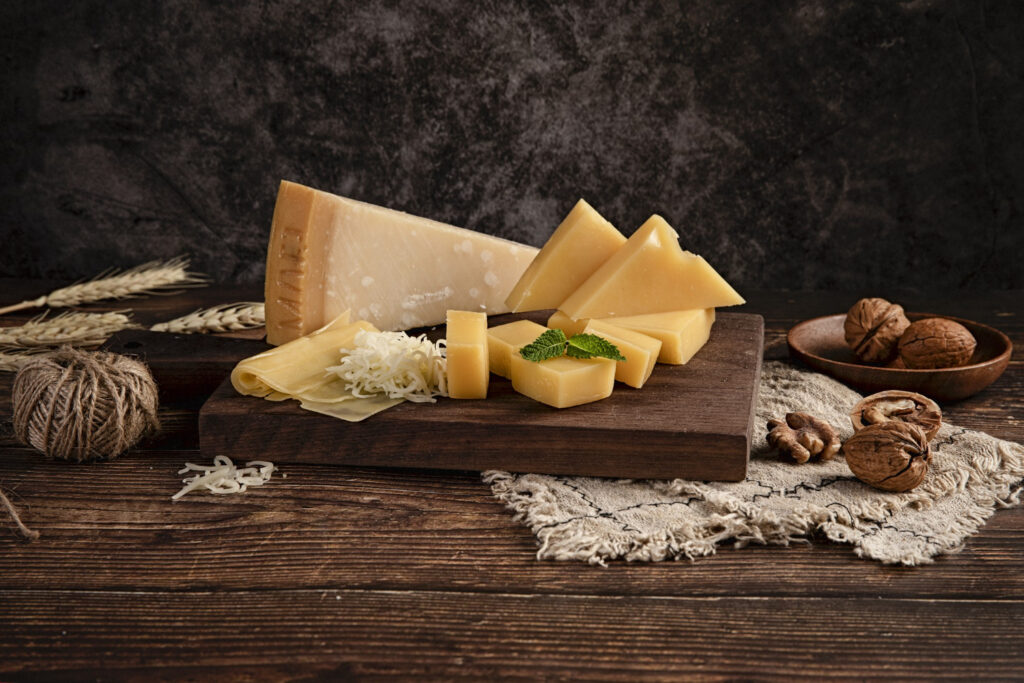Grana Padano is one of Italy’s most famous cheeses. It has a firm, grainy texture and a savory taste that people all over the world enjoy. Unlike soft cheeses that melt quickly, Grana Padano is hard and crumbly, which makes it perfect for grating over pasta, soups, and salads. It is also delicious on its own, eaten in small pieces with bread or wine.
What makes this cheese special is not only its taste but also its long history. It comes from Northern Italy and has been made in almost the same way for centuries. It is a cheese connected to Italian traditions, food culture, and daily life.
In this guide, we will explore the origins of Grana Padano, what makes it unique, how it is produced, and why it is so important in cooking. We will also look at its nutritional value, food and wine pairings, and tips for buying and storing it. Finally, we will answer common questions people often ask about this famous cheese.
By the end, you will understand why Grana Padano is more than just food. It is a piece of Italian history that continues to play an important role in kitchens around the world.
The Origins of Grana Padano
The story of Grana Padano begins in the 12th century in the Po Valley of Northern Italy. Monks living in monasteries wanted to find a way to preserve extra milk for longer periods. They discovered that by heating the milk, adding rennet, and pressing it into wheels, they could create a cheese that lasted for months and even years without spoiling.
The name “Grana” comes from the grainy texture of the cheese, while “Padano” refers to the Po River Valley region. Over time, the cheese became an essential part of Italian life, not just for farmers and monks, but for families across the country.
Culturally, it was a symbol of careful farming and food craftsmanship. Even today, when someone eats Grana Padano, they are enjoying a tradition that has been passed down for more than 900 years. It remains protected by the European Union with a PDO (Protected Designation of Origin) status, which means only cheese made in specific regions of Northern Italy using strict methods can be called “Grana Padano.”
What Makes Grana Padano Unique
One of the most unique things about Grana Padano is its texture. It has a firm, crumbly, and slightly grainy structure, which makes it different from softer cheeses. The flavor is rich but not overpowering. It is savory, slightly nutty, and has a gentle sweetness that develops as it ages.
Compared to Parmigiano Reggiano, which is its closest relative, Grana Padano is usually milder and slightly less sharp in taste. Parmesan has a longer minimum aging period, while Grana Padano can be aged for different lengths of time, creating cheeses that range from delicate to strong in flavor.
This variety makes it flexible in cooking. A younger Grana Padano is softer and milder, good for everyday dishes, while an older one has a deeper, more complex taste, perfect for special meals or wine pairings.
How Grana Padano Is Made
The production of Grana Padano follows traditional methods that have hardly changed since the Middle Ages. It starts with fresh cow’s milk collected in Northern Italy. The milk is partially skimmed, then poured into large copper vats where it is gently heated. Natural rennet is added to help the milk curdle and form solid curds.
These curds are broken into small pieces and cooked again, then pressed into large round molds to create the famous wheel shape. Each wheel is marked with a special stamp that shows it is authentic Grana Padano.
Aging is the most important part of the process. The wheels are stored in special rooms for at least nine months, though some are aged for more than two years. During this time, the cheese develops its flavor and texture. The longer it matures, the stronger and more aromatic it becomes.
Grana Padano in Everyday Cooking
In Italy, Grana Padano is used in many classic dishes. It is often grated over pasta, risotto, and soups to add a savory depth of flavor. It can also be shaved onto salads or vegetables, where its nutty taste balances fresh ingredients.
Outside of Italy, many people enjoy it in simple ways. A piece of Grana Padano with bread and olive oil makes a quick snack. It can also be part of a cheese board served with cured meats and fruit. Because it melts slowly, it works well baked into pies, casseroles, or savory pastries.
For home cooks, Grana Padano is easy to use. Whether you are making a traditional Italian recipe or a quick weeknight meal, it can add a touch of authentic flavor without requiring complex preparation.
Grana Padano and Nutrition
Cheese often gets mixed opinions when it comes to health, but Grana Padano has several benefits when eaten in moderation. It is high in protein, which supports muscles and overall health. It also contains important minerals like calcium and phosphorus, which help keep bones strong.
Another interesting fact is that Grana Padano contains very little lactose. During the long aging process, most of the lactose is broken down, which makes it easier for many people with lactose sensitivity to digest.
Of course, it is also rich in fat and calories, so moderation is important. But when included as part of a balanced diet, Grana Padano can provide valuable nutrients and flavor without being unhealthy.
Pairing Grana Padano with Food and Wine
Food pairing is part of the enjoyment of Grana Padano. Its nutty, savory flavor matches beautifully with many foods and drinks.
When it comes to wine, younger Grana Padano pairs well with light, fruity white wines such as Pinot Grigio, while older, aged varieties go well with full-bodied reds like Barolo or Chianti. For those who prefer non-alcoholic drinks, sparkling water or apple cider can complement the cheese’s richness.
As for food, Grana Padano is excellent with cured meats like prosciutto, fresh fruits like pears and apples, and even honey. The contrast between sweet and salty brings out the best in the cheese.
Buying and Storing Grana Padano
When buying Grana Padano, it is important to look for authenticity. True Grana Padano wheels are stamped with the PDO mark and checked for quality before being sold. Pre-packaged pieces should clearly state “Grana Padano PDO” on the label.
Storing the cheese properly is just as important. It should be wrapped in wax paper or parchment and then placed in an airtight container in the refrigerator. This prevents it from drying out while still letting it breathe. If stored correctly, a piece of Grana Padano can last for weeks without losing its flavor.
Conclusion
Grana Padano is more than just a cheese. It is a product of Italian history, culture, and food traditions that have lasted for centuries. From its origins in monasteries to its role in modern kitchens, it continues to be one of Italy’s most loved exports.
Its unique texture, balanced flavor, and versatility make it a favorite ingredient for both simple and sophisticated meals. At the same time, its nutritional value and digestibility add another reason why people around the world enjoy it regularly.
Whether grated over pasta, enjoyed with wine, or served in small chunks, Grana Padano is a cheese that brings both taste and tradition to the table. Exploring it in your own cooking is a way to connect with authentic Italian flavors and celebrate a timeless food.
FAQs
1. What is the difference between Grana Padano and Parmesan?
Grana Padano is usually milder and less sharp than Parmigiano Reggiano. Parmesan is aged longer and comes only from specific regions, while Grana Padano is produced in a wider area of Northern Italy.
2. How long can Grana Padano be aged?
It must be aged at least nine months, but some wheels mature for up to 24 or even 30 months. The longer it ages, the stronger the flavor.
3. Is Grana Padano lactose-free?
It is not completely lactose-free, but the lactose content is extremely low due to the long aging process. Many people with lactose sensitivity can enjoy it without problems.
4. Where can I buy authentic Grana Padano?
It is sold in many supermarkets, cheese shops, and online stores. Always check for the PDO mark to ensure authenticity.
5. Can I cook with Grana Padano instead of Parmesan?
Yes, in most recipes, Grana Padano can be used as a substitute. It may give a slightly different flavor, but it works well in pasta, risotto, and soups.




